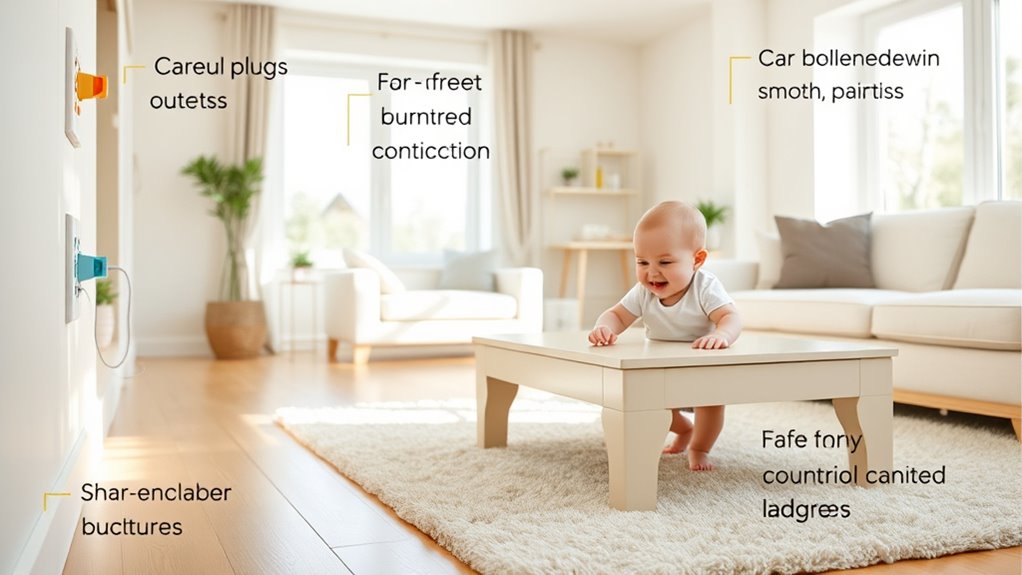To babyproof your home, start by installing safety gates at stairs to prevent falls and securing furniture to walls to avoid tipping. Manage cords from blinds and electronics using tiebacks or cord shorteners, and switch to cordless window coverings. Cover electrical outlets and remove small choking hazards. Remember, babyproofing is ongoing—regular checkups make certain your home stays safe as your child grows. Keep exploring to learn more simple steps that protect your little one effectively.
Key Takeaways
- Install safety gates at stairways to prevent falls and ensure they are securely anchored and snug-fitting.
- Secure cords from blinds, curtains, and electronics out of children’s reach using cord cleats or winders.
- Anchor furniture to walls and cover electrical outlets with safety plugs to prevent tipping and electrical hazards.
- Regularly reassess and update safety measures as your child grows to address new hazards.
- Remove small objects and ensure a safe environment to prevent choking, strangulation, and other injuries.

Babyproofing might seem overwhelming at first, but taking simple steps can make your home much safer for your little explorer. One of the most effective ways to prevent falls and keep your child out of dangerous areas is through safety gate installation. You’ll want to position gates at the top and bottom of stairs, making sure they’re securely anchored and fit snugly without gaps. Look for gates that are easy to open for adults but secure enough to prevent little ones from slipping through. Installing them correctly is key—follow the manufacturer’s instructions carefully, ensuring the gate doesn’t wobble or shift when pushed. Properly installed safety gates give you peace of mind, knowing your child can’t access potentially hazardous areas like stairwells or kitchens unsupervised.
Alongside safety gate installation, cord management strategies are essential to eliminate strangulation hazards. Cords from blinds, curtains, and electronics pose a serious risk to curious toddlers. To minimize danger, start by securing cords out of reach using cord cleats, tiebacks, or cord winders. Avoid leaving cords dangling where your child can grab them; instead, keep them tightly wound and fastened to the wall or window frame. If possible, replace traditional blinds with cordless options or those with inaccessible cords. For existing cords, use cord shorteners or tension devices that keep excess slack safely stored and out of reach. Regularly check cords for wear and tear, replacing any frayed or damaged ones immediately. The goal is to create a home environment where cords don’t tempt your little one to pull or climb, markedly reducing the risk of strangulation.
In addition to gates and cords, you should also focus on securing furniture, covering electrical outlets, and removing small objects that could be choking hazards. Every room requires a different approach, but the common thread is vigilance and proactive safety measures. Take the time to evaluate each space from your child’s perspective, identifying potential dangers and addressing them before accidents happen. Implementing comprehensive safety measures can further reduce the risk of injury by addressing multiple hazards simultaneously. Babyproofing isn’t a one-time task; it’s an ongoing process that adapts as your child grows and explores. When you prioritize safety gate installation and implement effective cord management strategies, you’re creating a safer environment where your child can explore confidently. Remember, the effort you put in now can prevent injuries later, giving both you and your little one added peace of mind as they begin to discover the world around them.
Conclusion
By babyproofing your home, you create a safer space where your little one can explore and enjoy. Remember, preparation prevents potential problems and protects precious lives. Stay vigilant by securing stairs, strangling hazards, and sharp corners. With a bit of effort and awareness, you’ll prevent potholes and pitfalls, turning chaos into comfort. Babyproofing isn’t just a task; it’s a commitment to caring, caution, and creating a secure sanctuary for your cherished child.








